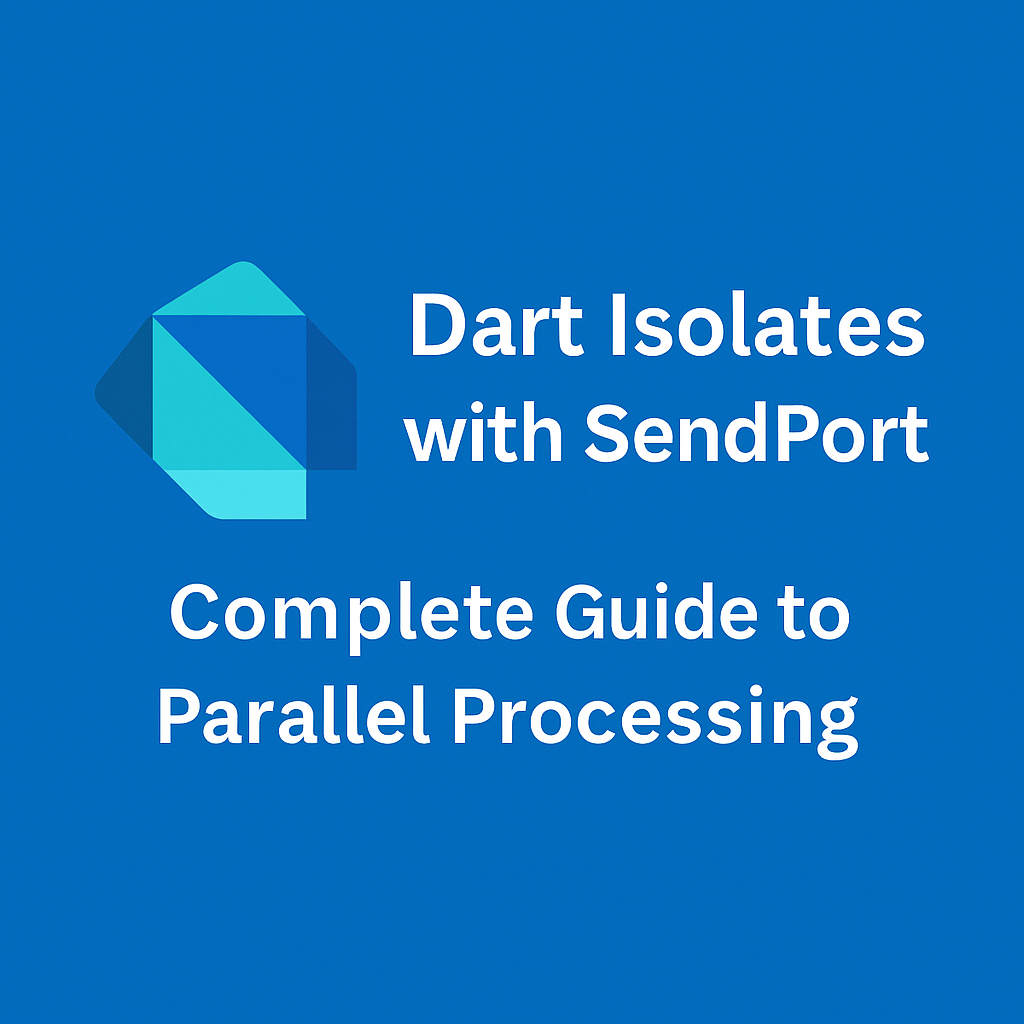Dart Isolates with SendPort : Complete Guide to Parallel Processing in Dart
Introduction
In Dart, performance bottlenecks can occur when intensive operations block the main isolate. Whether you’re building a Flutter app or a server-side Dart script, handling such tasks efficiently is crucial. This is where Dart isolates with SendPort come into play.
Isolates are Dart’s solution to true multithreading and concurrency. In this comprehensive guide, you’ll learn what isolates are, how SendPort and ReceivePort work together to enable communication, and how to implement isolates properly using real-world examples.
By the end, you’ll be confident in using Dart isolates with SendPort to boost performance and responsiveness in your applications.
What Are Dart Isolates?
Dart is a single-threaded language by default, meaning all code executes in a single isolate—the main isolate. While this simplifies app development, it introduces challenges when dealing with:
- Heavy computations
- Synchronous loops
- File I/O
- JSON parsing or data transformation
To overcome these challenges, Dart provides isolates, which are:
- Separate threads with their own memory space
- Able to run independently from the main isolate
- Communicate only through message passing, not shared memory
Isolates are a powerful tool, and SendPort is the mechanism used to send messages between them.
Understanding SendPort and ReceivePort
Because isolates cannot access each other’s memory, communication must happen through ports:
ReceivePortallows an isolate to receive messages.SendPortis obtained from aReceivePortand is passed to another isolate to send messages back.
This message-passing mechanism makes Dart isolates safe and predictable, without race conditions.
How it works:
- The main isolate creates a
ReceivePort. - It spawns a new isolate, passing the
SendPortto it. - The new isolate does its work and sends the result back using the
SendPort.
This is the core concept behind using Dart isolates with SendPort.
Real-World Example: Dart Isolate with SendPort
Let’s walk through an end-to-end example where we simulate a heavy computation (like summing a large range of numbers) using Dart isolates with SendPort.
Step 1: Import required libraries
import 'dart:isolate';
void computeSum(SendPort sendPort) {
int sum = 0;
for (int i = 0; i < 100000000; i++) {
sum += i;
}
sendPort.send(sum);
}
Step 2: Spawn the isolate from the main function
void main() async {
ReceivePort receivePort = ReceivePort();
await Isolate.spawn(computeSum, receivePort.sendPort);
receivePort.listen((data) {
print('Result received from isolate: $data');
receivePort.close();
});
}
Explanation:
- The main isolate spawns a new isolate.
- It provides a
SendPortthat the isolate uses to send the result. - The message is received on the
ReceivePort.
This basic implementation showcases how Dart isolates with SendPort can run parallel code efficiently.
Advanced Communication: Bidirectional Messaging
If you want two-way communication, you can pass a SendPort back from the isolate:
void bidirectionalTask(SendPort mainSendPort) {
ReceivePort isolateReceivePort = ReceivePort();
mainSendPort.send(isolateReceivePort.sendPort);
isolateReceivePort.listen((message) {
final result = "Processed: $message";
mainSendPort.send(result);
});
}
And in main():
void main() async {
ReceivePort mainReceivePort = ReceivePort();
await Isolate.spawn(bidirectionalTask, mainReceivePort.sendPort);
SendPort? isolateSendPort;
mainReceivePort.listen((message) {
if (message is SendPort) {
isolateSendPort = message;
isolateSendPort!.send("Hello Isolate");
} else {
print('Response: $message');
}
});
}
Key Benefits of Dart Isolates with SendPort
- Non-blocking performance: Offload CPU-heavy tasks
- True concurrency: Unlike
Futureorasync/await, isolates run on different threads - Safe communication: Memory is never shared, eliminating race conditions
- Scalable: Multiple isolates can be spawned for different workloads
Use Cases in Real Apps
You can use Dart isolates with SendPort for:
- Parsing large JSON in background
- Running real-time calculations
- Uploading/downloading large files
- Blockchain computations
- Image/video encoding
- AI/ML inferences in Dart-native servers
Common Pitfalls to Avoid
- Passing complex objects: Only send simple types (int, string, List, Map). Avoid custom classes unless they are serializable.
- Resource leaks: Always close
ReceivePortafter use. - Spawning too many isolates: Each isolate consumes system memory. Avoid overuse.
- Using isolate instead of compute: In Flutter, for simple use-cases use
compute()which handles spawn + sendPort automatically.
You can Read : How to Use Isolates for CPU-Intensive Tasks in Dart?
FAQ – Dart Isolates with SendPort
SendPort is used to send messages to a ReceivePort in another isolate. It enables communication between Dart isolates.
Yes. You use SendPort to send data back from an isolate to the main isolate.
You can send simple types like integers, strings, lists, maps, or other SendPorts. Avoid passing non-serializable custom objects.
Use isolates when tasks are CPU-intensive and async/await cannot prevent UI blocking.
Yes, and in fact, it’s recommended for background tasks, but isolate spawning must be done carefully to avoid resource overuse.
Understanding and using Dart isolates with SendPort is a powerful way to unlock performance and responsiveness in Dart and Flutter apps. While often overlooked, isolates are essential for any Dart developer working on data-heavy or compute-intensive tasks.
By combining the structured safety of isolates with the message-passing flexibility of SendPort, you get a concurrency model that’s both efficient and safe.
Don’t just rely on async functions — start using Dart isolates with SendPort today to write better, faster, and more scalable Dart applications.


